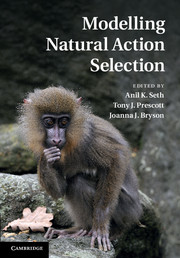Book contents
- Frontmatter
- Contents
- Foreword
- Preface
- Contributors
- 1 General introduction
- Part I Rational and optimal decision making
- 2 Introduction to Part I: rational and optimal decision making
- 3 Do we expect natural selection to produce rational behaviour?
- 4 Optimised agent-based modelling of action selection
- 5 Compromise strategies for action selection
- 6 Extending a biologically inspired model of choice: multi-alternatives, nonlinearity, and value-based multidimensional choice
- 7 Bayesian approaches to modelling action selection
- 8 Post-retrieval inhibition in sequential memory search1
- Part II Computational neuroscience models
- Part III Action selection in social contexts
- Index
- Plate section
- References
6 - Extending a biologically inspired model of choice: multi-alternatives, nonlinearity, and value-based multidimensional choice
from Part I - Rational and optimal decision making
Published online by Cambridge University Press: 05 November 2011
- Frontmatter
- Contents
- Foreword
- Preface
- Contributors
- 1 General introduction
- Part I Rational and optimal decision making
- 2 Introduction to Part I: rational and optimal decision making
- 3 Do we expect natural selection to produce rational behaviour?
- 4 Optimised agent-based modelling of action selection
- 5 Compromise strategies for action selection
- 6 Extending a biologically inspired model of choice: multi-alternatives, nonlinearity, and value-based multidimensional choice
- 7 Bayesian approaches to modelling action selection
- 8 Post-retrieval inhibition in sequential memory search1
- Part II Computational neuroscience models
- Part III Action selection in social contexts
- Index
- Plate section
- References
Summary
Summary
The Leaky Competing Accumulator (LCA) is a biologically inspired model of choice. It describes the processes of leaky accumulation and competition observed in neuronal populations during choice tasks and it accounts for reaction time distributions observed in psychophysical experiments. This chapter discusses recent analyses and extensions of the LCA model. First, it reviews the dynamics and it examines the conditions that make the model achieve optimal performance. Second, it shows that nonlinearities of the type present in biological neurons improve performance when the number of choice-alternatives increases. Third, the model is extended to value-based choice, where it is shown that nonlinearities in the value function, explain risk-aversion in risky-choice and preference reversals in choice between alternatives characterised across multiple dimensions.
Introduction
Making choices on the basis of visual perceptions is an ubiquitous and central element of human and animal life, which has been studied extensively in experimental psychology. Within the last half century, mathematical models of choice reaction times have been proposed which assume that, during the choice process, noisy evidence supporting the alternatives is accumulated (Laming, 1968; Ratcliff, 1978; Stone, 1960; Vickers, 1970). Within the last decade, data from neurobiological experiments have shed further light on the neural bases of such choice. For example, it has been reported that while a monkey decides which of two stimuli is presented, certain neuronal populations gradually increase their firing rate, thereby accumulating evidence supporting the alternatives (Gold and Shadlen, 2002; Schall, 2001; Shadlen and Newsome, 2001). Recently, a series of neurocomputational models have offered an explanation of the neural mechanism underlying both, psychological measures like reaction times and neurophysiological data of choice. One such model, is the Leaky Competing Accumulator (LCA; Usher and McClelland, 2001), which is sufficiently simple to allow a detailed mathematical analysis. Furthermore, as we will discuss, this model can, for certain values of its parameters, approximate the same computations carried out by a series of mathematical models of choice (Busemeyer and Townsend, 1993; Ratcliff, 1978; Shadlen and Newsome, 2001; Vickers, 1970; Wang, 2002).
Information
- Type
- Chapter
- Information
- Modelling Natural Action Selection , pp. 91 - 119Publisher: Cambridge University PressPrint publication year: 2011
References
Accessibility standard: Unknown
Why this information is here
This section outlines the accessibility features of this content - including support for screen readers, full keyboard navigation and high-contrast display options. This may not be relevant for you.Accessibility Information
- 1
- Cited by
